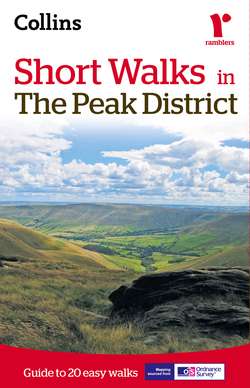Читать книгу Short walks in the Peak District - Collins Maps - Страница 7
What is the Peak District?
ОглавлениеThe title ‘Peak District’ is something of a misnomer. The name ‘Peak’, in fact, refers to a tribe who lived in the area in ancient times. In the year 924, a cleric writing about the hills and dales of what is now North Derbyshire, referred to the inhabitants as living in ‘Peaclond’ and the name seems to have stuck.
There are really two Peak Districts – Dark and White. The two areas are so completely different that, when standing on the breezy limestone plateau of the White Peak, it is hard to imagine that the untamed wilderness of Bleaklow and Kinder Scout are not far away. Broadly speaking, the Peak District can be sub-divided into six distinct areas;
• The most northerly is the wildest and covers the moors above Saddleworth and the Longdendale Valley with the huge spread of Bleaklow filling the space between Longdendale and the Snake Pass.
• Kinder Scout is a vast boggy plateau bordered to its south by Edale and the graceful sweep of the Mam Tor – Rushup Edge Ridge.
• To the east, rising above the Derwent Valley, there is a long escarpment which is clearly defined by a series of gritstone edges backed by heather moorland.
• In the west, gritstone crags range from The Roaches above Leek to Windgather Rocks and Castle Naze on the northern limits. High open moors offer miles of lesser known walking. Tranquil wooded valleys cutting the western moors are excellent places to walk on hot summer days.
• Limestone makes its most northerly appearance in dramatic cliffs and knolls above Castleton, a place of caves and ancient lead mines. South of Castleton are some of the highest villages in the White Peak. They can expect to be cut off by deep snow for several days during most winters.
• The limestone plateau to the southwest of the A6 is incised by deep valleys and is judged by many to be the prettiest part of the Peak. It is certainly a zone of contrasts where the lush pastures of the rolling uplands have been grazed by cattle since time immemorial. Rivers run pure and clear and they are full of lively trout.
People came early to the Peak. Settling first on the treeless limestone plateau, they left mysterious mounds and stone circles. The circle at Arbor Low between Hartington and Youlgreave was probably the most important. Certainly its surrounding earthworks indicate its significance. Arbor Low is unique as the stones lie flat, unlike the more familiar uprights associated with other circles.
During the Middle Ages, most of the lands were owned by various monasteries. They continued to exploit the lead resources, which was then very much in demand both as a roofing material and for constructing pipes to supply water into a growing number of monastic establishments. The monks opened large tracts of arable grazing and produced wool to clothe an expanding population. Farms which today have the word Grange as part of their name, were owned by rich monasteries until their dissolution by Henry VIII.
Great houses have been built in the Peak. Some are well known, like Chatsworth with its parkland, which was landscaped by Capability Brown, or Haddon Hall – a uniquely preserved medieval country house. There are also many lesser-known stately homes throughout the district which are just as interesting. Most are in private hands, like Tissington Hall which has been owned by the same family for generations. Hartington Hall, a fine example of a Jacobean yeoman’s house is now a youth hostel as is Ham Hall which is an early Victorian mansion preserved by the National Trust.
Visitors to the Peak can buy jewellery made from Blue John, a semi precious stone found only beneath Treak Cliff, near Castleton. Another Peak novelty is the Bakewell Pudding (never call it a tart!). This delicacy was first made accidentally by a 19th century cook working in the Rutland Arms Hotel. Very fine.
Famous writers have penned the virtues of the Peak but none has better links than Izaak Walton (author of ‘The Compleat Angler’ published in 1653), who fished The Dove with the poet Charles Cotton.
Industry has always made its mark. Pack horse, or ‘jaggers’ tracks can still be followed on foot over the northern moors. Saltways crossed the southern dales. Water-powered mills in the early part of the Industrial Revolution brought textile production to the dales. Fluorspar, a nuisance to the early lead miners, is now extracted by open cast mining and used as a flux in steel making and as the basis for a number of chemicals.
Today, without any doubt, it is quarrying which makes the greatest industrial impact on the face of the Peak District. Limestone, suitable either as road aggregates or for cement making, is often only found in scenically attractive areas and, as a result, the quarries can make an ugly scar on the landscape unless they are carefully monitored.
